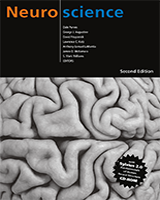By agreement with the publisher, this book is accessible by the search feature, but cannot be browsed.
NCBI Bookshelf. A service of the National Library of Medicine, National Institutes of Health.
Purves D, Augustine GJ, Fitzpatrick D, et al., editors. Neuroscience. 2nd edition. Sunderland (MA): Sinauer Associates; 2001.

Neuroscience. 2nd edition.
Show detailsMost inhibitory neurons in the brain and spinal cord use either γ-aminobutyric acid (GABA) or glycine as a neurotransmitter. Like glutamate, GABA was identified in brain tissue during the 1950s, and the details of its synthesis and degradation were worked out shortly thereafter. David Curtis and Jeffrey Watkins were the first to show several decades ago that GABA inhibits the ability of mammalian neurons to fire action potentials. It is now known that as many as one-third of the synapses in the brain use GABA as their neurotransmitter. Unlike glutamate, GABA is not an essential metabolite, nor is it incorporated into protein. Thus, the presence of GABA in neurons and terminals is a good initial indication that the cells in question use GABA as a neurotransmitter. GABA is most commonly found in local circuit interneurons, although the Purkinje cells of the cerebellum provide an example of a GABAergic projection neuron (see Chapter 19).
The predominant precursor for GABA synthesis is glucose, which is metabolized to glutamate by the tricarboxylic acid cycle enzymes, although pyruvate and glutamine can also act as precursors. The enzyme glutamic acid decarboxylase (GAD), which is found almost exclusively in GABAergic neurons, catalyzes the conversion of glutamate to GABA (Figure 6.10A). GAD requires a cofactor, pyridoxal phosphate, for activity. Because pyridoxal phosphate is derived from vitamin B6, a B6 deficiency can lead to diminished GABA synthesis. The significance of this became clear after a disastrous series of infant deaths was linked to the omission of vitamin B6 from infant formula. The lack of B6 resulted in a large reduction in the GABA content of the brain, and the subsequent loss of synaptic inhibition caused seizures that in some cases were fatal.

Figure 6.10
Synthesis, release, and reuptake of the inhibitory neurotransmitters GABA and glycine. (A) GABA is synthesized from glutamate by the enzyme glutamic acid decarboxylase, which requires pyridoxal phosphate. (B) Glycine can be synthesized by a number of (more...)
The mechanism of GABA removal is similar to that for glutamate: Both neurons and glia contain high-affinity transporters for GABA. Most GABA is eventually converted to succinate, which is metabolized further in the tricarboxylic acid cycle that mediates cellular ATP synthesis. The enzymes required for this degradation, GABA aminotransferase and succinic semialdehyde dehydrogenase, are both mitochondrial enzymes. Inhibition of GABA breakdown causes a rise in tissue GABA content and an increase in the activity of inhibitory neurons. Drugs that act as agonists or modulators on postsynaptic GABA receptors, such as benzodiazepines and barbiturates, are used clinically to treat epilepsy and are effective sedatives and anesthetics.
The distribution of the neutral amino acid glycine in the central nervous system is more localized than that of GABA. About half of the inhibitory synapses in the spinal cord use glycine; most other inhibitory synapses use GABA. Glycine is synthesized from serine by the mitochondrial isoform of serine hydroxymethyltransferase (Figure 6.10B). Once released from the presynaptic cell, glycine is rapidly removed from the synaptic cleft by specific membrane transporters. Mutations in the genes coding for some of these enzymes result in hyperglycinemia, a devastating neonatal disease characterized by lethargy, seizures, and mental retardation.
- GABA and Glycine - NeuroscienceGABA and Glycine - Neuroscience
Your browsing activity is empty.
Activity recording is turned off.
See more...